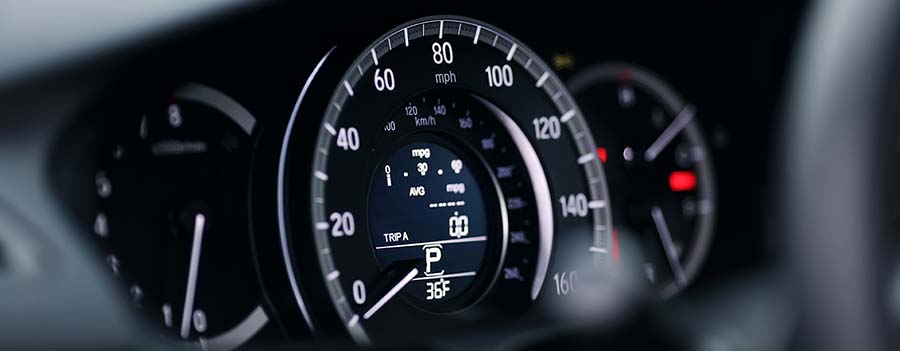What is Kick Down in a Car, and When Should You Use It?

If you drive a vehicle with automatic transmission, you may have heard of “kick down”. The term may even pop up in the Driving Theory Test. But just what is kick down in a car? How does it work? And should you be using it?
We have everything you need to know about using kick down to enhance the performance of your car.
What is the meaning of kick down?
So, what is kick down? It’s simply a way you can improve the acceleration in a vehicle with automatic transmission. It’s the equivalent of using your gear stick to move down a gear in a manual vehicle.
With an automatic vehicle, of course, there’s no gear stick. So instead your car uses the movement of the accelerator to determine when to drop a gear. (The way this works can be different, depending on how old your car is. We’ll take a look at that later.)
In lower gears, less of the engine’s power is used to turn the wheels quickly. That leaves more power available to accelerate fast.
What do you use kick down for?
With an automatic transmission, kick down is used whenever you want to increase the force applied by the engine. In practical terms, that could be when:
You want to overtake a vehicle — accelerating quickly will enable you to return to your lane as fast as possibleYou’re going uphill — the steeper the hill, the more force will be needed to overcome gravity and maintain your speedYou’re towing something heavy — like a caravan. And that goes double if you’re towing it uphill!
How does kick down work in an automatic car?
In older automatic transmission cars, kick down usually happens only when the accelerator is pressed to the floor.
In modern automatic cars, it’s a more sophisticated process, controlled by the car’s computer. It compares the position of the accelerator, and how quickly it’s being pressed, with the rate of acceleration. If the computer determines that the car isn’t accelerating rapidly enough, it initiates kick down.
Whatever process gets it started, kick down means the car shifts into a lower gear. That’s usually one gear down. But in newer cars, it could be two gears or even more, if the computer determines the engine won’t over-rev.
The lower gear reduces the amount of the engine’s power being used to turn the wheels, and increases the force, or torque. The result is more oomph, letting you maintain your speed up steep hills, or zoom past the car in front.
How do I activate kick down?
In modern automatic transmission cars, drivers shouldn’t need to think about activating kick down. All you’ll need to do is press the accelerator.
The car will take into account the position of the pedal and how fast it’s moved. And if it determines that more power is needed, it will kick down a gear (or more than one) as necessary.
Some modern automatic cars also give the driver the chance to switch between modes.
The standard mode is the most efficient in its use of fuel. The other — often called something like “Sports” or “Performance” — takes longer to switch up a gear. And it kicks down more quickly too. The result is higher acceleration, and more power uphill or when towing.
But if your automatic transmission car is older, things will likely be more basic. To activate kick down, you’ll simply need to press the accelerator to the floor. That presses a kick down switch, which shifts the transmission down a gear.
Unlike modern vehicles, the switch mechanism will only move down one gear at a time.
What do I do if kick down stops working?
So we’ve answered the question of what is kick down. But what happens when it stops working?
The answer to that depends on the type of system in your car. If it’s a simple switch, the culprit could be the switch itself, the valve it opens and closes, or a slack kickdown cable. It could even be something as simple as loose carpet preventing the pedal from going all the way down.
For some cars, replacing the kickdown switch is relatively straightforward. If you’re confident tinkering with your motor, it’s something you could tackle yourself. Check out online owners’ forums for the make and model of your car for info on what to do.
With a modern car, the array of sensors and the links to the car’s computer makes things far more complicated. In this case, it’s best to call in the professionals.
It’s worth being aware that sometimes your car will prevent kick down deliberately. Many modern cars have a safety function that will stop kick down being initiated if there’s a risk of the engine overheating. So if you’re trying to engage kick down when the engine’s RPM is too high, nothing will happen.
Can using kick down damage my vehicle?

In modern cars, kick down is part of a sophisticated system that links together sensors, transmission and engine. It won’t let you over-rev the engine. And you don’t need to worry that using it will cause any other problems for your car.
For older vehicles with a kick down switch under the accelerator, there are different views on how it can affect performance.
Some manufacturers encourage owners to use the kick down switch regularly. This, they say, prevents the switch from sticking. Some mechanics, on the other hand, argue that kick down can overload the engine and lead to wear and tear on the transmission.
So if you have an older vehicle, there’s no clear answer. The safest course of action is probably to use kick down in moderation. That will also be easier on your fuel consumption.
What else can I do to accelerate faster?
If you’re asking yourself “What is kick down?”, you’re probably interested in acceleration. Kick down is certainly one way to make an automatic car accelerate faster. But there are other options to consider too.
A good starting point is regular car maintenance. That means making sure the right tyres are fitted and kept at the right pressure. And it means regular checks of your engine.
It’s also possible to upgrade your car with a gizmo called a “throttle response controller”. That allows you to customize the sensitivity of your accelerator.
It won’t give you more power — if you put the pedal to the floor, your car will respond in just the same way. But you’ll get more acceleration for a lighter press on the pedal. Depressing it, say, 30 per cent, could give you the same acceleration as depressing it 70 per cent before.
Another option is to install a Turbocharger. This uses your vehicle’s exhaust gases to force more air into the engine, increasing its power. Superchargers perform a similar function, but in this case, they’re powered mechanically.
One thing to be aware of, though, is that some vehicle modifications have to be declared to your insurer. And they can affect the cost of your insurance. Turbochargers and superchargers both fall into this category, and both can increase your premiums.
What is kick down? The key points
So what is kick down in an automatic car? The key thing to remember is that it’s about acceleration. The most obvious time to use it is when you’re overtaking, but it’s also very useful when you’re going uphill or towing a heavy load.
Exactly how it works depends on the age and model of your car. Older vehicles with automatic transmissions usually have a simple switch that’s engaged when you press the pedal to the floor.
With modern vehicles, a sophisticated array of sensors means you should rarely have to think about kick down at all. Your car will detect automatically when you need more power and shift down accordingly.
Kick down is something you do when you need faster acceleration in that moment. But if you want to permanently increase the rate of acceleration, you can make modifications to your car. Just be aware that those may well increase the amount you pay for insurance.
Also read:
What factors affect performance car insurance?
Do I need high performance car insurance?
How do I get high performance car insurance?





